Optical microscopes provide two-dimensional information but are unable to measure the surface contour of sample features such as roughness, depth and volume. Taylor Hobson, a world leader in ultraprecision metrology, offers a novel solution to this problem with high-speed, high-resolution 3D measurement of an exceptionally large range of different materials and textures.
The CCI MP-HS optical profilometer, based on the patented Coherence Correlation Interferometry technique, can determine surface roughness and make volume calculations that differentiate between surface scars of a similar area, making it ideal for detailed tribology analysis of many different types of samples. In some cases wear scars features that were not visible during 2D analysis can clearly be seen and characterized with the CCI.
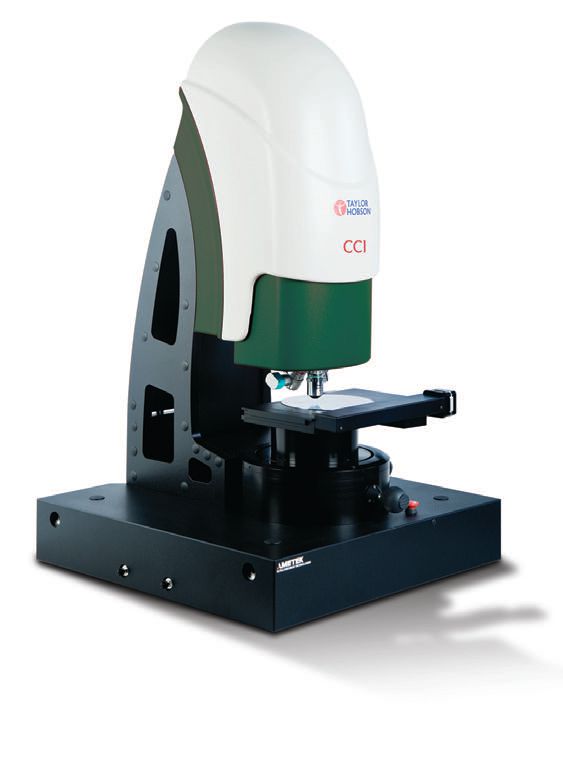
Nye Lubricants is a leading formulator, manufacturer and distributor of high-quality synthetic lubricants, thermal coupling compounds and index matching optical gels. It services a broad range of markets, including auto motive, in-vacuum manufacturing, aerospace, defense, medical device and photonics. Nye has added CCI optical surface profilometry as part of its comprehensive testing of its lubricants.
Nye conducted standardized SRV and 4-ball tests of various grease and lubricant formulations in order to directly compare results from a CCI MPHS using its Coherence Correlation Interferometry technique with those taken with an optical microscope. The test results clearly demonstrated the capabilities of both techniques and the advantages of the CCI approach.
Optical Microscopy vs. Optical Profilometry
Oil Test-Linear Oscillation
Two sets of balls and discs are subjected to the same test conditions. Both sets tested with renewably sourced hydrocarbon oil. Sample J includes biodegradable wear additive. Sample K is standard synthetic hydrocarbon oil.
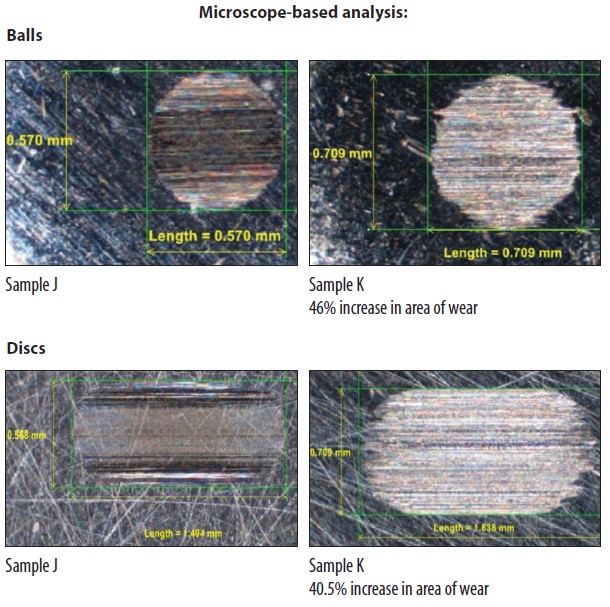
Traditional 2D microscope methods provided Nye with length, width and approximate area of wear scars created while testing its cutting-edge lubricant formulas. With Taylor Hobson’s CCI technology, Nye was able to accurately quantify length, width, area, volume and roughness, as well as create 3D visualizations of how the test specimen’s material had been displaced.
Nye acquired a CCI MP-HS this year following an on-site demonstration at its facilities. Nye quickly recognized the benefits of 3D measurements compared with 2D microscopic techniques for industry standard tests such as SRV and 4-ball wear tests.
“Using the CCI MP-HS we were able to gain valuable insight into how different additives influence wear on a specimen. In the case of very lightly worn specimens it is often difficult with an optical microscope to locate the edge of a scar and to measure the exact amount of lost material,” notes John Doherty, Research Chemist with Nye Lubricants.
“The CCI made locating the scar and calculating material volume loss easy. Its 3D visualization capability allows us to see the true shape of the wear scar as well as determine whether or not the surface material has been moved, worn or a combination of both.”
“We ran parallel SRV tests under the same conditions and with the same hydrocarbon oil. An additive was added to one sample, while the other had none,” he notes. “Using the 2D microscopic area measurement, we determined that the sample with the additive was 40% more effective against wear. When we used the CCI volumetric data, we found that the oil with the additive was actually 800% more effective, making the product twenty times better than we had previously thought.”
“In the instance of an extremely aggressive pressure wear test, observations made under the microscope indicated that one specimen passed the test of a 0.8 mm maximum width with 0.75 mm scar and another failed with a scar width of 1.0 mm. With the microscope, the second specimen appeared to be 33% worse than the first, not far from passing,” he adds.
“With the CCI we were able to precisely measure the 1.0 mm scar. The results revealed a specimen that was deeply gouged with over 20 times the wear volume than the more lightly scarred specimen, a significantly different result.”
The CCI MP-HS offers both high speed and high resolution, with scan speeds of up to 105 microns/second without any loss in data quality and sub nano meter Z resolution over the entire measurement range. Its unique combination of AutoStitch and high-speed performance gives comprehensive results in minutes rather than hours. Claritas20 light conditioning offers unrivalled data quality. Increased sensitivity provides less missing data on hard to measure surfaces and an increase in maximum angle capability, improving data quality and opening up new exciting application opportunities.
Optical Microscopy vs. Optical Profilometry
Oil Test-Linear Oscillation (SRV)
Two sets of balls and discs are subjected to the same test conditions. Both sets tested with renewably sourced hydrocarbon oil. Sample J includes biodegradable wear additive. Sample K is standard synthetic hydrocarbon oil.
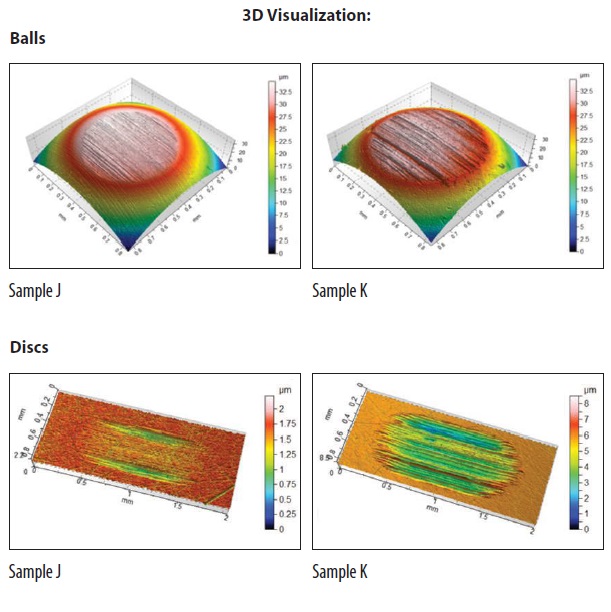
To simplify the setting up and staging of components, the CCI MP-HS offers innovative features such as AutoRange, AutoFringeFind and multisite measurement routines as well as the more traditional autofocus option. This reduces the possibility of human error and lowers cycle time. The instrument’s high-speed sensor and large field of view (FOV) means fewer set ups, faster inspection speed, and better utilization of operators and equipment.
The CCI MP-HS is designed for long-term cost effectiveness with builtin diagnostic tools for quick and easy troubleshooting and ease of operation that reduces the probability of operator mishandling. Even with infrequent use, retraining and close supervision of operators is not required.
The CCI MP-HS is able to identify surface flaws or areas of concern anywhere within its field of view and uses proprietary software to zoom in for more detailed analysis. Its large field of view and fine lateral resolution give highly detailed datasets for detailed surface analysis and provide stunning 3D images.
Optical Microscopy vs. Optical Profilometry
Oil Test-Linear Oscillation (SRV)
Summary: Balls
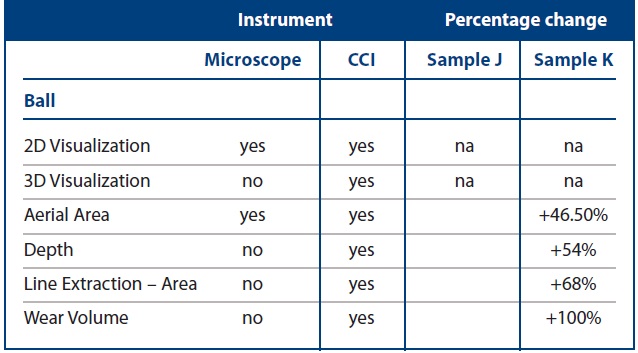
Among the instrument’s key advantages is its TalyMap proprietary software, which accurately calculates wear volumes for both flat and spherical surfaces. The software is designed for greater flexibility, faster operating speeds and improved overall performance. Its advanced analytical capabilities include photo-realistic, full-color images and enhanced productivity tools, including templates for repetitive work and automatic report generation based on batches of measurement data. 4D analysis of 3D surfaces offers the ability to study changes in the surface over time.
“Our results with the CCI MP-HS are far better than those we were able to achieve previously,” comments Mr. Doherty. “The TalyMap software allows us to better differentiate between test results and provides us with the ability to present those results in formats that are easier to understand, especially for those who are not expert in profile measurement.”
Optical Microscopy vs. Optical Profilometry
Oil Test-Linear Oscillation (SRV)
Summary: Discs
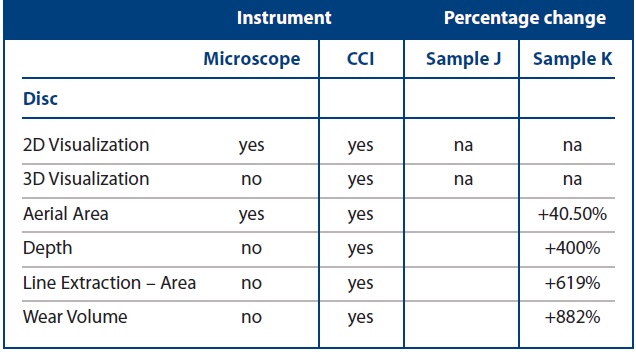
Taylor Hobson is a pioneer in ultraprecision measurement instruments and the developer of Coherence Correlation Interferometry. This patented technique provides a large measurement range, high-resolution images, short measurement cycle times and an exceptional ability to measure surfaces of different materials and textures.
Taylor Hobson is a unit of AMETEK, Inc, a leading global manufacturer of electronic instruments and electromechanical devices with annualized sales of $3.5 billion. For more information, contact Taylor Hobson, 1725 Western Drive, West Chicago, IL 60185, USA. Tel: 630-621-3099. Fax: 630-231-1739. E-mail: sales@taylorhobson.us.
Web site: www.taylor-hobson.com